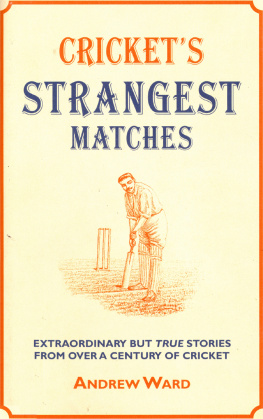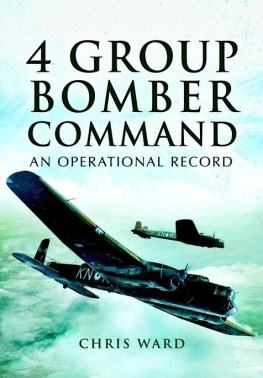
Other titles in this series
Footballs Strangest Moments
Golfs Strangest Rounds
Rugbys Strangest Matches

CONTENTS
A GREAT SINGLE-WICKET GAME
LEEDS, OCTOBER 1857
Single-wicket games were exceptionally popular in the 19th century, when transport systems were undeveloped and getting twenty-two players in one place was not easy. Also, they offered ample opportunities for betting on specific individuals. It was crickets answer to boxing.
Like boxing, however, not all the matches went the distance. A two-innings match in Tasmania, between Babington and Newbury in October 1896, lasted only four balls, a wicket falling on each ball. Other single-wicket games were totally one-sided. In 1820, Budd (70 and 30) beat Brande (0 and 0) after tactically knocking down his own wicket in each innings so as to prevent the possibility of too much stiffness when bowling. The big-publicity match in May 1838, played at Town Mailing between Alfred Mynn and James Dearman for a purse of 100 guineas, attracted 5,000 spectators, who were largely disappointed by the spectacle if not the betting. Mynn scored 34 and 89, Dearman managed 0 and very few. Double-wicket or treble-wicket competitions, that is, two or three a side, were generally reckoned to be more entertaining. One of the most unusual double-wicket games was played near Rickmansford in May 1827, when a man and his thoroughbred sheepdog beat two Middlesex gentlemen.
There were no complaints about the excitement generated by the match at Kirkstall, Leeds, in October 1857, when John Grange of Dacre Banks played against James Sadler of Leeds. Each player was allowed one fielder. Grange chose William Swain, the Richmond professional, who coached him before the event. Sadler chose George Atkinson, but Joseph Appleyard had to deputize for the latter when the game went into a second and third day.
The game started at 11.45 on Tuesday 15 October. Grange, batting first, lasted two and a half hours. In that time he faced 159 balls, made 80 hits, scored 17 runs off the bat and collected 10 more for wides. The dearth of runs was caused by the rules of the day, which compelled a batsman to cover a distance of 40 yards to complete a run. Grange was out when Atkinson caught him at mid-off.
When Sadler went in, Swain fielded like two men. On one occasion he ran flat out in an attempt to catch a skier, avoiding a spectator on the way before lunging desperately at the ball, and tearing off a nail from his little finger in the process of not quite making the catch.
As news of the game spread around the district, hundreds left work at Kirkstall Forge and made their way to the Victoria Ground, Woodhouse Moor, where, with blackened faces, they stood watching with interest and money at stake. This match (it was stated) caused more excitement in Leeds and its neighbourhood than any other contest for the last twenty years, documented MCC Cricket Scores and Biographies. Sadler amassed 24 runs off 93 balls, and was three behind on first innings. The stakes were 50 per side.
The game resumed the next morning, and Sadler began with underhand daisy-cutters, soon switching to overarm. Rain stopped play when Grange reached 21, and play was held over until the third day.
On the Saturday, the weather fine, Grange took his score to 24, made off 96 balls, setting Sadler 28 to win. On the 14th ball a huge shout for leg-before-wicket went up, and tension ran high. The appeal was turned down. On the 18th ball, Sadler hit the ball high and far. The ball hung in the air for a long time. Granges coach and fielder, William Swain, tore after the ball once again, running a long, long way 40 yards according to Bells Life before catching it with his left hand and landing with his back resting against the fence. He had won the game for his student.
GRANGE
John Grangec Atkinson b Sadler | | c and b Sadler | |
Wides | | |
| |
SADLER
James Sadler b Grange | | c Swain b Grange | |
Wides | | |
| |
CRICKET ON ICE
CAMBRIDGE, DECEMBER 1878
The fields of the Fens were full of water, and the water froze. People took to skating and races were organized across the smooth fields.
But there was one other sport which generated interest during the cold winter of 18789, a sport which automatically comes to mind when looking out of frosty windows on to a field of perfect ice in the midst of a harsh winter. Yes, it was, of course, cricket.
The Cambridge University term had ended, so Charles Pigg challenged a team from the town to a game on an ideal icy field at Grantchester Meadows, scene of Chaucers Reeves Tale and close to the residence (in different eras) of Rupert Brooke and Jeffrey Archer. The Town-Gown game was played over three days on a wicket which didnt show the slightest sign of wearing badly. No fast bowling was allowed. The umpires were severe on anything other than lobs.
The Town batted first and the scoring was heavy. Robert Carpenter opened the innings and helped himself to the first 50 of the match. Charles Pigg, the Gown captain, gave his team two overs each in order to assess what they could do. He eventually settled on Lilley and Boucher as his mainstream lob attack. Boucher, writing to The Times 50 years later, recalled a moment when he lobbed up a full toss to Dan Hayward as the crack batsman was going strong. Hayward, imagining how the ball would look in the next county, swung heartily and overbalanced on the ice. The ball bowled him, and the 12-man Town team were all out for 328.
The Gown batted and were 61 for one at close of play on the second day. Fielders chased and slid across the ice in exhilarating fashion as they tried to keep down the Gown score. Three of the first five batsmen raced to fifties, and the two Piggs put together a solid fifth-wicket stand. Time ran out when the Gown team needed another 55 runs for victory with seven wickets standing. The game was an honourable draw.
Cricket on ice has occasionally been revived since, but conditions abroad are often more favourable than in Britain. Cricket in a frozen fjord would really be something, although it would need specially qualified umpires to test the thickness of the ice.
CAMBRIDGE TOWN
R. Carpenter c Scott b Boucher | |
W. Thurston run out | |
F. Pryor c Scott b Boucher | |
J. Warrington b Lilley | |
G. Hoppett b Lilley | |
J. Fordham b Wawn | |
H. Mason c Wawn by Lilley | |
W. Newman run out | |
A. Fromant lbw b Lilley | |
W. Richardson b Lilley | |
D. Hayward b Boucher | |
J. Cain not out | |
|
CAMBRIDGE GOWN
von E. Scott run out | |
Lilley b Newman | |
W. Deedes b Newman | |
A. D. Wawn c and b Carpenter | |
Next page




















